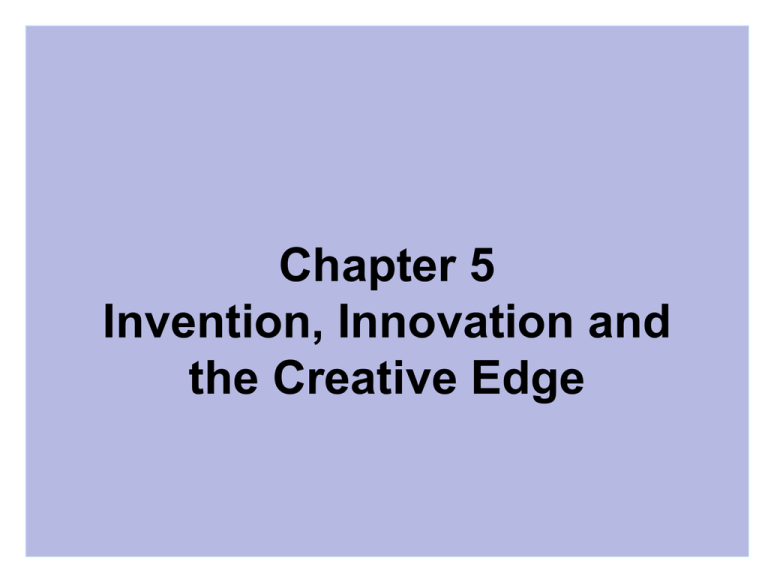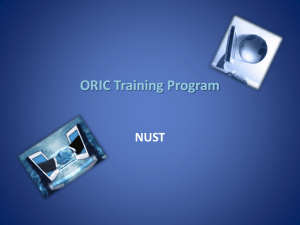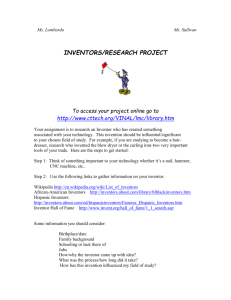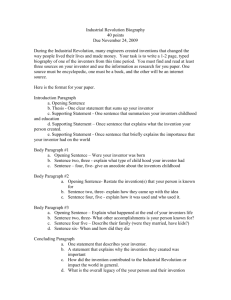Chapter 5 Invention, Innovation and the Creative Edge
advertisement

Chapter 5 Invention, Innovation and the Creative Edge Good Ideas are… • Innovative: – Something no one has thought of before – Has never been made to work before • Satisfy a need Where do you look for new ideas? 1. 2. 3. 4. 5. 6. 7. 8. Internet Nature Talking to friends Stores TV Magazines Dreams Some ways to find new ideas • Newspapers: articles, classifieds, ads, • Magazines: consumer, trade, specialty • Trade Shows: displays How observant are you? • Do test p91 with partner • Then repeat Where can you get ideas for a new business venture? • Look for: – Change • Change can spur an idea for a new venture – Patterns • Watch how people shop, interact, talk about ideas but then do nothing with those ideas Developing an idea • Get an idea – research it – talk to others >> ideas, support – keep records of everything Pop Quiz • Page 92 #1, #2 Invention or Innovation Invention and Innovation • Invention and innovation are closely linked for the successful entrepreneur or enterprising person. • Most new ideas begin with a “What if???” • Chris Haney asked, “What if I invent a game that ask trivia questions?” – Trivial Pursuit. • Jacques Plante asked, “What if I wear a mask to protect my face?” – Goalie Mask • Before we look at the future and what has been invented, let’s look at the past and see how far we have come Examples of Inventions • • • • • • • • Velcro Internet Basketball Telephone Automobile Camera Cornflakes Zipper Television Toboggan Lacrosse Kayak Birch Bark Canoe Lie Detector Slinky Crayons Radio Tractor Yo - Yo Frisbee Photocopier Helicopter Hula Hoop Electric Shaver Examples of Innovations • • • • • • • • • Coloured Ketchup Cell Phone Plasma Screen T.V. Tea Bag Disposable Camera Roller Blades Contact Lenses Cake Mix Teddy Bear Instant Coffee Life Savers Pop-Up Toaster Band-Aid Pez Candy Barbie Doll Drive-In Theatre Canned Beer Toyota’s Hybrid Car Awesome and Innovative Bathtub Design Ideas Invention • the creation of something new Innovation • a change to something that already exists CANADIAN HALL OF FAME ENTREPRENEURS • • • • • • • • • • • William & Alfred Billes – Canadian Tire Armand Bombardier – Bombardier George Cohon – MacDonald’s Canada Timothy Eaton – Eaton’s K. C. Irving – Irving Empire Lord Thompson – Hudson Bay & Thompson Empire Wallace & Harrison McCain – McCain Foods Ed Mirvish – Honest Ed’s Frank Stronach – Auto Parts Garfield Weston - Weston’s Guy Laliberte & Guy Caron – Cirque du Soleil Local Entrepreneurs (Ontario) • • • • • Mac Voison- M&M Meats Christine Magee – Sleep Country Canada John Sleeman – Sleeman Brewery Claus Werner – Automated Tooling Systems Donald Triggs – producer and marketer of wine Canadian Inventors • • • • • • • • • • • • • • • Basketball by James Naismith in 1891 Chocolate Nut Bar by Arthur Ganong in 1910 Electric Light Bulb by Henry Woodward 1874 Garbage Bag by Harry Wasylyk in 1950 Goalie Mask by Jaques Plante in 1960 Gramophone invented by Bell and Emile Berliner in 1889 Radio-Transmitted Voice by Reginald Fessenden in 1904 Snowblower by Arthur Sicard in 1925 Snowmobile by Joseph Bombardier in 1922 Standard Time by Sir Sanford Fleming in 1878 Television by Reginald Fessenden in 1927 Lawn Sprinkler by Real McCoy 5 Pin Bowling by T.E. Ryan in 1909 Ear Piercer by Thomas Ahearn 1882 Zipper by Gideon Sundback in 1913 Canadian Women Inventors • Rachel Zimmerman – 12 year old inventor of Computerized Blissymbolics Program • Olivia Poole – inventor of the Jolly Jumper. • Dianna Croteau – inventor of the CPR mannequin • Dr. Emily Stowe – founder of Women’s College Hospital • Pam Townsend – inventor of “The Ski Whiz” allows anyone to water ski and gives beginners confidence. • Stella Quesnelle - A wheeled lawn rake for gardening and landscaping. • Betty Duffield - The Mug Muff is a knitted tube worn to protect the neck and lower face. It has a loose pocket to cover the mouth and warm in-coming air and it can be rolled down into a turtleneck or pulled up to frame the face. • Top 5 Japanese Inventions • YouTube Read p 94-95 and fill in the chart Inventor What did they invent Read p 94-95 and fill in the chart Inventor What did they invent James Write Synthetic rubber Paul Hodgson Silly Putty Jacques Plante Goalie mask Ruth Wakefield Chocolate chunk cookies Michael Duck Dispense cream (Tim Horton’s) Protecting Your Ideas Patent • A government grant giving the right to exclude others from making, using or selling an invention. A Canadian patent applies within Canada for 20 years from the date of filing of a patent application. The patent application is available to the public 18 months after filing. Summary of steps to obtain a patent in Canada 1. Find a patent agent. 2. Do a preliminary search. (If there's an existing patent, consider ending the process now.) 3. Help your agent prepare a patent application. 4. File your application. 5. Request examination. 6. Examiner does search for prior patents and studies claims. 7. Examiner either approves or objects to the claims. 8. Respond to examiner's objections and requirements. 9. Examiner reconsiders and either approves or calls for further amendments. 10. If final decision is objected to, you may appeal. Fees • There are three kinds of fees you must pay to obtain a patent: • filing fees, $2,500 • examination fees and $1,000 • grant of patent fees $150-$700 • Yearly maintenance fees are required to maintain an application or a patent in force. • Patent infringement would occur if someone made, used or sold your patented “door lock” without your permission in a country that has granted you a patent, during the term of the patent. If you believe your patent is infringed, you may sue for damages in the appropriate court. • Protection before grant When you obtain a patent in Canada, you will be able to sue infringers for all damages sustained after the grant of your patent. Also after grant, you may sue for reasonable compensation for infringements that occurred in Canada from the date your application was made available for public inspection (18 months after filing) to the date of grant. • Trade secrets You may be tempted to protect your creation by simply keeping its information secret and selling it to a willing buyer. The information is then known as a trade secret. Patent marking and "patent pending" The Patent Act does not require that patents be marked as "Patented." However, marking an article as patented in Canada when it isn't is against the law. You may wish to mark your invention "Patent Applied For" or "Patent Pending" after you have filed your application. These phrases have no legal effect but may serve as warnings to others that you'll be able to enforce the exclusive right to manufacture the invention once a patent is granted. Copyrights • Provide protection for literary, artistic, dramatic or musical works • e.g., books, maps, song lyrics, music, sculptures, paintings, photographs, films, tapes, computer programs, databases, performances, sound recordings, communication signals • author has the right to have his/her work copyrighted • unless they were hired or employed to create it • cannot publish, perform, translate, adapt without permission • upon death, heirs hold copyright for 50 years Trademarks • A word, symbol or design (or a combination of these), used to distinguish the wares and services of one person or organization from those of others in the marketplace. • Ordinary marks - logo • Certification marks - ISO 9000, TM, CSA • Distinguishing guises - unique packaging or shape Industrial Design Act • An industrial design is anything made by hand, tool or machine that has a distinctive feature – register the design • yours for 10 years i.e., chair Integrated Circuit Topography Act • An Act to provide for the protection of electronic integrated circuit topographies • protected for 10 years • Assignment: • p 97 #2 (research) • p 98-99 #1,2 Assignment: • Draw ten trademarks associated with different types of products on or close to your person right now. • Choose one of the trademarks you drew. Describe IN DETAIL why you think the company might have chosen this trademark for its product. Include design meaning, colour meaning Assignment: Inventors • There are many famous-and not-so-famousCanadian inventors and innovators. Sometimes, an invention is well known but the inventor is not. Other inventors have become more famous than many of their inventions. In this activity, you will have the opportunity to visit Web sites that feature Canadian inventors and innovators, both past and present. • Chart: • Search each of the following sites and compile a list of 10 Canadian inventors or innovators and their inventions or innovations. Use the outline below to compile your findings. CANADIAN INVENTORS AND INNOVATORS • Canadian Inventor/ Innovator • Invention/Innovation (include a brief description of what the invention/innovation does or what it is used for) • Were you familiar with this Canadian and his or her accomplishments before you began this activity? (Yes or No) • Famous Canadian Inventors Web page • http://www.melazerte.com/library/inventors.htm • Inventors in Canada Web site • http://www.inventors.ca/ • • • • E-Library: http://elibrary.bigchalk.com/ce/canada/ Eden’s username: 53-59442 Eden’s password: bigchalk Inventor Presentation & Report • Select one of the inventors or innovators which is different from all others in the class and prepare a report and a power point presentation on your findings. You will present this to the class. Sign up for your inventor as each presentation must be different. • Report: title page, introduce inventor/innovator, what they are famous for, how idea originated, how idea was developed, how product got to marketplace, problems along the way, result, where it is today, bibliography • Slide Show: 20 slides – 10 minutes The Problem Solving Process The Problem-Solving Process 7. Is the problem solved? If not, choose another idea and try again. 6. Try out your idea 5. Rank your ideas and select the best one 4. Use your criteria for evaluating ideas 3. Establish criteria for evaluating ideas 2. Generate lots of possible solutions 1. Think about the problem • Problem Solving Innovative Thinking Speaker Jim Feldman • http://www.youtube.com/watch?v=vJBE1Wv1Law 5.59 min • Very cleaver • Depth • Distance • Determination Lateral Thinking • Break from standard – think sideways (not forward, up or down) – see unique perspective “outside-the-box” • YouTube – Solar Bottle Lights in the Philippines • http://www.youtube.com/watch?v=SBWi3NtND68 • Edward de Bono - discusses Lateral Thinking™ • http://www.youtube.com/watch?v=Nb9Oe83ruUw 3.39 min • good intro • Edward de Bono on creative thinking • http://www.youtube.com/watch?v=UjSjZOjNIJg 4.19 min • expert in lateral thinking or creative thinking Assignment: Define lateral thinking. Describe a time when an entrepreneur you met or read about used this type of thinking to solve a problem. • Indigo Introduces de Bono's Six Thinking Hats® • http://www.youtube.com/watch?v=K4IkCdBTxxE&f eature=related • 1.39 min • Good intro • Edward de Bono Six Thinking Hats (1of6) • • • • http://www.youtube.com/watch?v=3Mtc_CBTIeI 10.34 min Good into a little deep Then look at the other videos Thinking Hats • White – gathers facts, figures, objective info – Unemotional • Red – recognizes emotion & intuition influence – goes by hunches, feelings without judgment or logic • Green – creative, see alternatives, proposals – likes provoking, irritating, change Thinking Hats • Black – will present logical case against idea – gives negative feedback unemotionally • Yellow – logical, sees positives, why things work – assess benefits • Blue – problem solvers – solve everyone’s problems / makes it happen Assignment: Complete the chart Thinking Hat White Hat Red Hat Green Hat Black Hat Yellow Hat Blue Hat What It Means Questions the How It Could Thinker Help You Plan Might Ask Your Venture • The Problem-Solving Process • Read pages 100 – 104 • P105 Complete the “Cool Stuff” activity – Hand in a summary of your findings with your questions • Answer Q #1 • Q #4 • Interpreting Information • How many squares? See text p 106 #2, #3 Solving Problems • there are many ways to find solutions • ask 10 people, you will get 11 answers • the best problem solvers are constantly searching – note details without losing perspective of whole • How to Find More Answers – see text p 107 Teamwork • two minds better than one • people build on other’s ideas • teamwork builds on your strengths, provides support • work alone: – run out of ideas and energy Right Brain / Left Brain • Left Brain – sequential, analytical, linear – contain the function of language and languagerelated activities • Right Brain – creative, imaginative, emotional, intuitive – get sudden insights TEAMWORK = left and right work together • exercise both parts of your brain • Right Brain/ Left Brain Quiz – http://www.intelliscript.net/test_area/questio nnaire/questionnaire.cgi – What kind of brain do you have???? • Right Brain vs Left Brain Creativity Test – http://www.wherecreativitygoestoschool.com/v ancouver/left_right/rb_test.htm – Did this test agree with the previous one? • Personality Test – http://www.wherecreativitygoestoschool.com/v ancouver/left_right/rb_test.htm – Did this test agree with the first two? Assignment • p109#1, 2, 3, 4, 5 Generating Ideas • Word Clustering – word in middle – group like ideas • Mind Mapping – picture in middle (similar to word clustering) – associate key words and images Generating Ideas • Brainstorming – record all ideas, even strange ones – used frequently in business • Visualization – create picture of idea in your mind



![Introduction [max 1 pg]](http://s3.studylib.net/store/data/007168054_1-d63441680c3a2b0b41ae7f89ed2aefb8-300x300.png)

